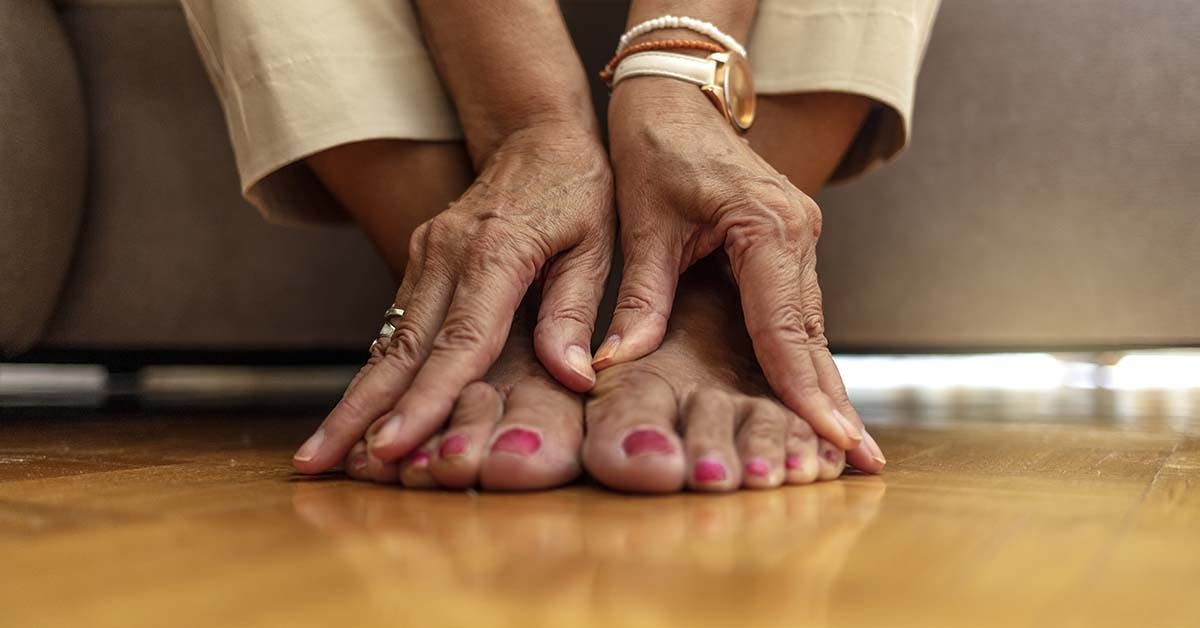Total Joint Care

Our primary objective in providing total joint care services is to collaborate with you as an individual and identify the most suitable options that can enhance the quality of your life.
We strive to assist you in regaining the ability to engage in the activities that bring you joy. Our team comprises skilled professionals with vast knowledge and proficiency in treating various joint conditions. We adopt a personalized approach that tailors techniques and technologies to your specific requirements.
Our passion lies in empowering you to achieve healthy mobility and sustain healthy living in the long run. We eagerly anticipate the opportunity to consult with you soon.
Can you explain the joint injection process?
At Spruce Health Group, joint injections are administered directly to the injured or damaged joint using a needle. Our team utilizes the innovative Advanced Arthritis Relief Protocol (AARP) and an intra-articular system to ensure the safe and efficient delivery of medication.
As a Medicare-preferred alternative to knee replacement surgery, our joint injections incorporate fluoroscopy guidance to ensure that the medication is precisely administered to the injured or damaged area within the joint.
Typically, our providers recommend a weekly visit to Spruce Health Group for joint injections during the treatment period. With time, you should experience a reduction in symptoms such as discomfort, pain, and joint stiffness resulting from cartilage or soft tissue damage.
Hyaluronate is a key ingredient in our joint injections, providing a thick substance that effectively lubricates the joint. With improved lubrication, the damaged joint can move more smoothly and comfortably, improving your overall quality of life.
For what specific conditions can joint injections be used as a treatment?
Joint injections are a highly effective treatment option for joint damage caused by osteoarthritis, with a particular focus on the knee joint. Additionally, your healthcare provider may recommend joint injections to relieve pain in other areas like the shoulder, elbow, wrist, or ankle. Osteoarthritis is the most common type of arthritis, which occurs as a result of the gradual deterioration of the cartilage in the joints due to wear and tear.
The knee joint is especially susceptible to cartilage degeneration from osteoarthritis due to the significant weight it bears and its role in supporting body movement. Normally, healthy cartilage absorbs the impact of movement, but with osteoarthritis, it can cause discomfort, stiffness, or instability. Joint injections can help improve joint lubrication, leading to smoother and more comfortable movement.
Your knees are particularly susceptible to cartilage degeneration from osteoarthritis because they support a significant portion of your body weight and are responsible for maintaining stability while you stand, walk, or run. Normally, healthy cartilage helps absorb the shock of movement, but with osteoarthritis, it can cause discomfort, stiffness, or instability. Joint injections can enhance joint lubrication, leading to smoother and more comfortable movement.
“When I get my shot it DOESN’T hurt at all. And it’s really pain-free. My knees are really messed up. They treat me like a person with no number. While she is doing the injection my Nurse Practitioner keeps asking if I’m doing ok. She makes sure you’re not in pain. Spruce Health Group is AWESOME they treat you like people. You all are AWESOME…”
Rhonda D. – 2021
What can I anticipate following joint injections?
Joint injections offer a less taxing and uncomfortable recovery option than joint replacement or repair surgery. Nevertheless, there are certain restrictions to follow. After each joint injection at Spruce Health Group, it is recommended to limit your activity for approximately 48 hours. Your provider may advise you to refrain from:
- Prolonged standing or walking
- Jogging or running
- Playing sports
- Lifting heavy objects
The swelling and discomfort may initially intensify following your injection. If this persists, contact Spruce Health Group for further guidance. To achieve the best outcomes, it is essential to follow aftercare instructions and adhere to your injection schedule.
It may take up to three rounds of injections before observing an improvement in your osteoarthritis symptoms. For a more comprehensive treatment approach, the team may suggest physical therapy and nutritional guidance.
If you are experiencing pain or stiffness in one or both of your knees or another painful joint due to cartilage damage from osteoarthritis, contact Spruce Health Group to schedule a joint injection consultation or request an appointment today.

What is osteoarthritis?
Osteoarthritis, which is also known as degenerative arthritis or wear-and-tear arthritis, is caused by a combination of factors, including overuse, repetitive movements, trauma, and natural wear-and-tear on the joints. Symptoms arise when the cartilage that normally cushions the ends of the bones in the joints deteriorates or is worn away.
This condition commonly affects a single joint, often in the shoulder, hip, or knee, but can develop in any joint that experiences frequent use in your daily life or occupation.
What are the symptoms?
To accurately diagnose and treat OA, it’s recommended to schedule an appointment at Spruce Health Group for a thorough examination. OA can present with a range of symptoms that are not exclusive to this type of arthritis, making an accurate diagnosis crucial.
Typical symptoms of OA include:
- Joint tenderness or pain
- Mild joint swelling
- Stiffness or limited range of motion
- Improvement of symptoms with movement
- Cracking or clicking sounds when the joint moves
- Worsening pain after activity or at the end of the day
The development of OA can take years, so if you’re experiencing persistent joint pain for more than a few days, it’s advisable to seek medical attention to identify the cause of your pain and prevent further joint damage.
How can osteoarthritis potentially affect me?
If left untreated, osteoarthritis can cause a complete breakdown of cartilage in the affected joint, resulting in bone-on-bone contact and worsening of symptoms, which may require surgery to alleviate discomfort and improve joint function. Additionally, osteoarthritis can lead to bone breakdown near the joints, associated with osteoporosis, which increases the risk of fractures in these areas.
How is osteoarthritis diagnosed and treated?
Diagnosis of osteoarthritis involves a consultation, physical examination, and X-rays. In cases where osteoporosis is suspected, a bone densitometry test or a DEXA scan may be ordered to evaluate bone density.
Lifestyle changes, such as weight loss and wearing joint braces during activity, along with medications to reduce pain and inflammation, are commonly used to treat osteoarthritis. Some medications may also help prevent cartilage breakdown and preserve joint health. PRP treatments may also be recommended by your healthcare provider to stimulate healing in the affected area.
If you’re looking for osteoarthritis treatments, you can contact Spruce Health Group or request an appointment online.

What is shoulder pain?
Shoulder pain is a prevalent musculoskeletal condition that can affect either one or both shoulders. Despite being powerful and having a broad range of motion, shoulder joints can be hindered by disease or injury, leading to significant pain and discomfort.
The shoulder joint consists of three bones: the humorous, clavicle, and scapula. The acromioclavicular joint and the glenohumeral joint are supported by a layer of cartilage. All these components work together in harmony to enable arm movements in various directions.
Although anyone can experience shoulder pain, it is more commonly observed in individuals over the age of 60. This is because the soft tissues that support the shoulder may wear away with age.
What are some typical causes?
Shoulder pain can have various causes, with the most common being rotator cuff tendinitis. Additionally, other health issues that can result in shoulder pain include:
- Osteoarthritis
- Torn cartilage
- Torn rotator cuff
- Pinched nerve
- Frozen shoulder
- Broken shoulder
- General wear-and-tear
- Sports or work-related injury
What is the process of diagnosing shoulder pain?
Your medical provider at Spruce Health Group will perform a comprehensive physical examination, review your medical history, and ask about your symptoms and lifestyle to diagnose shoulder pain. During the exam, they will evaluate the range of motion and stability of your shoulder.
If additional information is required, your provider may recommend diagnostic imaging procedures such as an MRI or X-ray. These tests provide a closer look at the bones, tendons, and ligaments in your shoulder.
How is shoulder pain addressed?
At Spruce Health Group, the treatment for shoulder pain is tailored according to the intensity of your symptoms and the underlying cause. The team at Spruce Health Group prefers using minimally invasive and integrative treatments to alleviate pain and enhance mobility.
Your provider might recommend treatment with:
- Joint injections
- Physical therapy
- Platelet-rich plasma (PRP) injections
- Tissue supplementation
Additionally, healthy lifestyle changes like maintaining a balanced diet, exercising regularly, and managing stress levels may prove beneficial. Your healthcare provider might suggest a combination of various treatments to improve your condition.
The ultimate objective of treatment is to mitigate pain, enhance mobility, and restore your overall quality of life.
Do not let pain hinder your active and mobile lifestyle. To book a consultation at Spruce Health Group, contact the nearest office and speak with a team member, or schedule an appointment online today.

What are the possible injuries that can impact my elbow?
At Spruce Health Group, our team has effectively addressed elbow pain and other injuries or disorders related to the elbow, such as:
- Fractures
- Tendon strains and tears
- Ligament sprains and tears
- Tennis elbow (lateral epicondylitis)
- Golfer’s elbow (medial epicondylitis)
- Arthritis
- Elbow (olecranon) bursitis
- Elbow instability
The Spruce Health Group team also excels at treating complex trauma involving some or all of the structures in your elbow.
What makes the elbow work?
Your elbow consists of three bones:
- Humerus
- Radius
- Ulna
The elbow joint is formed by the junction of the humerus, which is the upper arm bone, with the radius and ulna bones of the forearm. The bicep and tricep muscles located in the upper arm are responsible for controlling most of the elbow movements.
Moreover, a significant nerve, the ulnar nerve, runs through the elbow. In case you have ever experienced a tingling sensation after hitting your elbow / “funny bone”, it’s your ulnar nerve that’s been affected.
The elbow joint plays a crucial role in ensuring the proper positioning of your hand during daily activities. It is susceptible to acute injuries and can also be impacted due to overuse or compensating for injuries in other body parts.
At Spruce Health Group, our team can diagnose your injury and develop a personalized treatment plan that will assist in restoring your usual active routine.
How is elbow pain diagnosed?
In order to determine the appropriate treatment plan for your elbow pain, your healthcare provider at Spruce Health Group will first evaluate your elbow. This involves a thorough examination of the joint, a review of your medical history, and a discussion of your symptoms as well as overall health.
The subsequent step is to conduct diagnostic testing, which may involve procedures like X-rays, MRI scans, CT scans, or nerve function studies. Once your provider identifies the underlying cause of your elbow pain, treatment can begin.
What methods are used to treat elbow pain?
Initially, your provider will typically suggest non-surgical options as a preferred approach for treating elbow pain. The initial treatment methods for elbow pain may involve:
- Splinting
- Bracing
- Casting
- Medications
- Physical therapy
- Steroid injections
- Regenerative medicine
In most instances, non-surgical techniques for addressing elbow pain prove to be effective. However, if your pain does not improve with conservative treatment, your healthcare provider may suggest elbow surgery as an option.
If you are experiencing elbow pain, you can schedule a consultation at Spruce Health Group by calling the clinic or booking an appointment online.

What can cause ankle pain?
Our team at Spruce Health Group can assist in identifying the root cause of your ankle pain, followed by devising an appropriate treatment plan.
The ankle joint is responsible for connecting your feet to your legs and supporting the majority of your body weight while standing, walking, or running.
Similar to other joints, the ankle comprises bone, cartilage, and soft tissues, such as muscles, ligaments, and tendons, which can sustain damage from injuries, degenerative disorders, or age-related wear and tear. Some common causes of ankle pain include:
- Nerve compression
- Poor structural alignment
- Bone fractures
- Osteoarthritis
- Tendinitis (tendon inflammation)
- Gout
- Joint infection
Are there additional symptoms that accompany ankle pain?
Apart from pain and discomfort, ankle injuries and degenerative damage may also produce other symptoms. These additional symptoms, along with diagnostic imaging and tools, can aid your healthcare provider in making an accurate diagnosis. When discussing your ankle pain with the team at Spruce Health Group, it is important to mention any accompanying symptoms, such as:
- Redness and swelling
- Tingling or burning
- Instability
- Bruising
- Stiffness
- Trouble standing or walking
If your ankle pain is mild, it may resolve on its own without treatment. However, you should schedule an appointment with Spruce Health Group if you experience difficulty standing or walking if the pain persists despite home remedies, or if you notice excessive swelling and bruising around the joint.
What are the recommended procedures for relieving ankle pain?
Spruce Health Group provides various options to alleviate ankle pain. After an initial consultation and assessment, your provider designs a customized plan to alleviate your pain and instability with long-term results in mind. Your tailored plan may include:
- Physical therapy
- Bracing
- Joint injections
- Platelet-rich plasma (PRP) injections
- Tissue supplementation regenerative therapy
- Weight loss
Your Spruce Health Group team will assist you in scheduling follow-up appointments to monitor your injury or condition’s progress over time. They may also provide nutritional advice to help reduce inflammation and alleviate ankle pain, and they are available to address any concerns or questions you may have during the course of your treatment.
How can I take care of my ankle at home?
There are steps you can take at home to help manage your ankle pain and enhance your overall treatment progress. These include utilizing heat and ice therapy, elevating your ankle while resting to reduce swelling, and taking over-the-counter anti-inflammatory medications.
If you would like to explore all of your options, please contact Spruce Health Group for further information or schedule a consultation online.

What causes wrist pain?
Wrist pain is a prevalent musculoskeletal issue that can affect individuals of all age groups. It can be caused by acute injuries such as sprains or fractures, as well as chronic underlying health conditions like carpal tunnel syndrome or osteoarthritis.
If you frequently experience wrist pain and find that it does not improve with conservative self-care methods such as rest, icing, or over-the-counter pain medications, it is important to promptly seek professional medical assistance.
What are the typical symptoms?
The symptoms can differ based on the underlying cause. Some individuals may encounter a dull and throbbing pain, while others may experience sharp, stabbing pain or sensations like pins-and-needles.
The specific location and intensity of your wrist pain can assist your healthcare provider at Spruce Health Group in determining the root cause.
What are some common causes?
The team at Spruce Health Group regularly diagnoses and treats pain caused by:
- Sudden impact injuries
- Repetitive stress injuries
- Osteoarthritis
- Rheumatoid arthritis
- Ganglion cysts
Keinbock’s disease is another prevalent factor contributing to wrist pain. This condition leads to the collapse of one or more small bones in the wrist due to compromised blood supply to the area.
Who is susceptible to wrist pain?
Wrist pain can affect individuals from all walks of life, but certain factors can elevate the risk. These include engaging in sports activities, having a job that involves repetitive movements of the wrist, or having a chronic health condition such as diabetes or obesity.
How is wrist pain diagnosed?
Your healthcare provider at Spruce Health Group examines your medical history, inquires about your lifestyle and symptoms, and performs a comprehensive physical examination. During the examination, your provider assesses your wrist for tenderness, swelling, or deformities, and observes your range of motion by asking you to move your wrist.
If these initial measures do not provide sufficient information for a diagnosis, your provider may recommend additional diagnostic testing such as an X-ray or MRI. These tests allow for a closer examination of the bones, joints, and soft tissues that support your hand and wrist.
What are the treatment options for wrist pain?
The treatment approach for wrist pain is determined based on the severity of symptoms and the underlying cause. At Spruce Health Group, the team utilizes conservative and integrative treatments whenever possible, which may include:
- Joint injections
- Bracing
- Physical therapy
- Platelet-rich plasma (PRP) injections
- Tissue allografts
You may find relief and improvement from one or a combination of these treatments. The ultimate objective of treatment is to alleviate pain, enhance mobility, and enhance your overall quality of life.
To explore the available treatment options, we encourage you to schedule an appointment at Spruce Health Group. Give us a call and speak with a team member or conveniently book a consultation online today.
